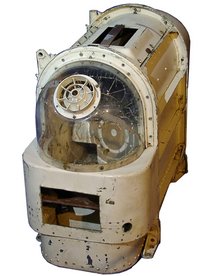 Original russian space Dog box used on suborbital and orbital flights
Original russian space Dog box used on suborbital and orbital flights|
From Wikipedia the free encyclopedia, by MultiMedia |
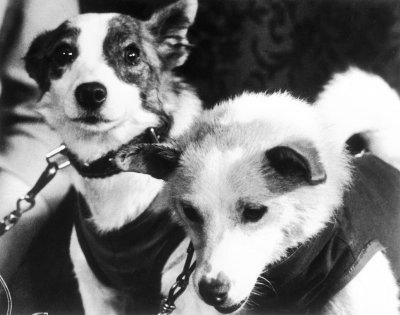 Belka and Strelka orbited the Earth and returned safely on Korabl-Sputnik-2
Belka and Strelka orbited the Earth and returned safely on Korabl-Sputnik-2During the 1950s and 1960s the USSR used a number of Dogs for sub-orbital and orbital space flights to determine whether human spaceflight was feasible. Before becoming cosmonauts, the Dogs were strays from Moscow. In total in the 1950s and 60s, the Soviet Union launched missions with passenger slots for at least 57 Dogs. The actual number of Dogs in space is smaller as some Dogs flew more than once.
Stray Dogs, rather than animals accustomed to living in a house, were chosen because the scientists felt they would be able to tolerate the rigours and extreme stresses of space flight better than other Dogs. Female Dogs were used because of their temperament and the fact that they did not need to lift their leg to urinate.
Their training included standing still for long periods of time, wearing space suits, being placed in simulators that acted like a rocket during launch, riding in centrifuges that simulated the high acceleration of a rocket launch and being kept in progressively smaller cages to prepare them for the confines of the space capsules. Dogs that flew in orbit were fed a nutritious gel.
 Original russian space Dog box used on suborbital and orbital flights
Original russian space Dog box used on suborbital and orbital flights
Several Dogs made high-altitude flights on R-1 series rockets between 1951 and 1952.
Dezik (Дезик) and Tsygan (Цыган, "Gypsy") were the first Dogs to make a sub-orbital flight on July 22, 1951. Both Dogs were recovered unharmed after travelling to a maximum altitude of 100km. Dezik made another flight in September with a Dog named Lisa, although neither survived.
Lysa (Лиса, "Fox" or "Vixen") and Ryjik (Рыжик, "Red One") flew to an altitude of 100km on June 2, 1954.
Smelaya (Смелая, "Bold" or "Courageous") was due to make a flight in September but ran away the day before the launch. Russian officials feared she had been eaten by wolves but she was found the next day and went on to make a successful flight with a Dog named Malyshka (Малышка, "Little One").
Bolik (Болик) ran away just days before her flight in September 1951. A replacement named ZIB (allegedly, a Russian acronym for "Substitute for Missing Dog Bolik") was quickly located and made a successful flight.
Otvazhnaya (Отважная, "Brave One") made a flight on July 2, 1959 along with a rabbit named Marfusha (Марфуша, "Martha") and another Dog named Snezhinka (Снежинка, "Snowflake"). She went on to make 5 other flights between 1959 and 1960.
Albina (Альбина, "Whitey") and Tsyganka (Цыганка, "Gypsy girl") were both ejected out of their capsule at an altitude of 85km and landed safely. Albina was one of the Dogs shortlisted for Sputnik 2 but never flew in orbit.
Damka (Дамка, "Little Lady") and Krasavka (Красавка, "Little Beauty") were both planned to make an orbital flight on December 22, 1960, however after the upper stage rocket failed the flight was aborted. Both were recovered successfully after an unplanned sub-orbital flight. Damka was also known as Shutka (Шутка, "Joke") and Zhemchuzhnaya (Жемчужная, "Pearly") and Krasavka was also known as Kometka (Кометка, "Comet") and Zhulka (Жулька, "Mutt?").
Other Dogs that flew on sub-orbital flights include Dymka (Думка, "Smoky"), Modnitsa (Модница, "Fashionable") and Kozyavka (Козявка, "Little Gnat").
At least four other Dogs flew in September 1951 with two or more lost.
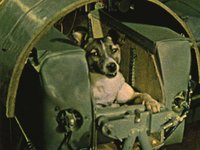 Laika became the first living being in orbit on Sputnik 2
Laika became the first living being in orbit on Sputnik 2
Main article: Laika
Laika (Лайка, "Barker"), originally named Kudryavka (Кудрявка, "Little Curly") became the first living Earth-born creature in orbit aboard Sputnik II on November 3, 1957. Some call her the first living passenger to go into space, but others claim sub-orbital flights passed the edge of space first. She was also known as Zhuchka (Жучка, "Little Bug") and Limonchik (Лимончик, "Lemon"). The American media dubbed her "Muttnik." She died between five and seven hours into the flight from stress and overheating. Her true cause of death was not made public until years after the flight, with officials giving conflicting reports that she was either euthanized by poisoned food or died when the oxygen supply ran out. The Russian scientist responsible for the project has since expressed regret for allowing Laika to die.
Bars (Барс, "Panther" or "Lynx") and Lisichka (Лисичка, "Little Fox") died after their rocket exploded 28.5 seconds into the launch on July 28, 1960. Bars was also known as Chayka ("Gull").
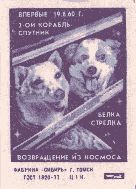 Russian Stamp commemorating Belka and Strelka
Russian Stamp commemorating Belka and Strelka
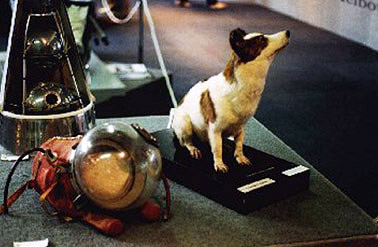 Stuffed Strelka on tour in Australia in 1991
Stuffed Strelka on tour in Australia in 1991
Belka (Белка, literally, "Squirrel," but as a Dog's name it more likely means "Whitey", from Russian: "belyi" (for "white") and Strelka (Стрелка, "Little Arrow") spent a day in space aboard Korabl-Sputnik-2 (Sputnik 5) on August 19, 1960 before safely returning to Earth. They were accompanied by a grey rabbit, 40 mice, 2 rats, flies and a number of plants and fungi. All biological passengers survived. Strelka went on to have six puppies, one of whom named Pushinka (Пушинка, "Fluffy"), was sent to President John F. Kennedy's children as a present. Pushinka's descendents are still living today.
After death, the bodies of both Strelka and Belka were preserved. Belka is on display in Moscow, while Strelka continues to tour the world as part of a travelling exhibition.
Pchelka (Пчелка, "Little Bee") and Mushka (Мушка, "Little Fly") spent a day in orbit on December 1, 1960 on board Korabl-Sputnik-3 (Sputnik 6) with "other animals", plants and insects. Due to a navigation error their spacecraft disintegrated during re-entry on December 2 and all were killed. Mushka was one of the three Dogs trained for Sputnik 2 and was used during ground tests. She did not fly on Sputnik 2 because she refused to eat properly.
Chernushka (Чернушка, "Blackie") made one orbit on board Korabl-Sputnik-4 (Sputnik 9) on March 9, 1961 with a cosmonaut dummy (whom Russian officials nicknamed "Ivan Ivanovich"), mice and a Guinea pig. The dummy was ejected out of the capsule during re-entry and made a soft landing using a parachute. Chernushka was recovered unharmed inside the capsule.
Zvezdochka (Звездочка, "Little Star"), who was named by Yuri Gagarin, made one orbit on board Sputnik 10 on March 25, 1961 with a wooden cosmonaut dummy in the final practise flight before Gagarin's historic flight on April 12. Again, the dummy was ejected out of the capsule whilst Zvezdochka remained inside. Both were recovered successfully.
Veterok (Ветерок, "Little Wind") and Ugolyok (Уголёк, "Ember") were launched on February 22, 1966 on board Voskhod 3 and spent 22 days in orbit before landing on March 16. This spaceflight of record-breaking duration was not surpassed by humans until Skylab 2 in 1974 and still stands as the longest space flight by Dogs.